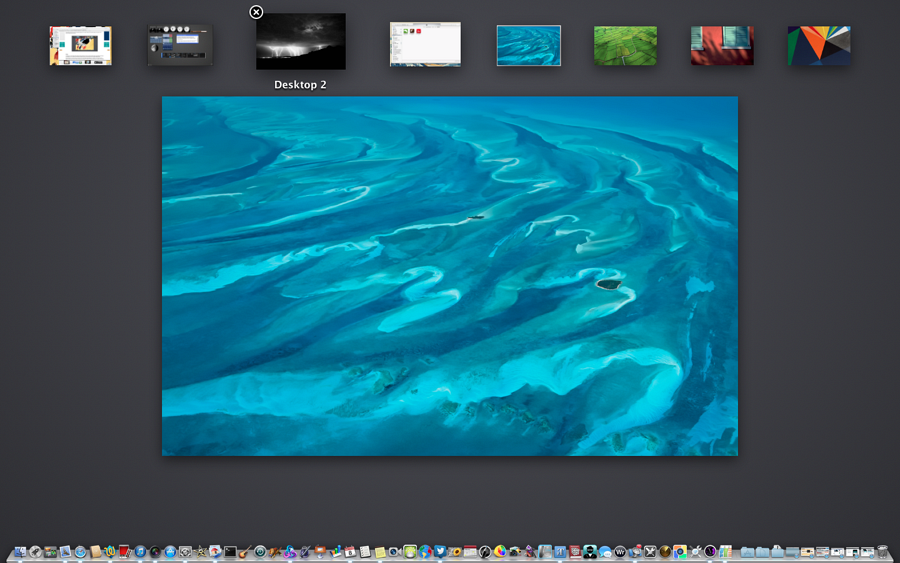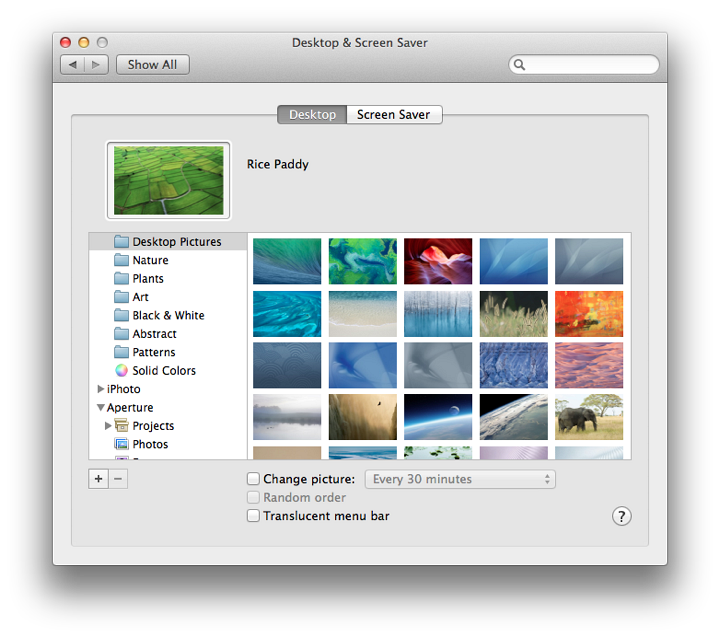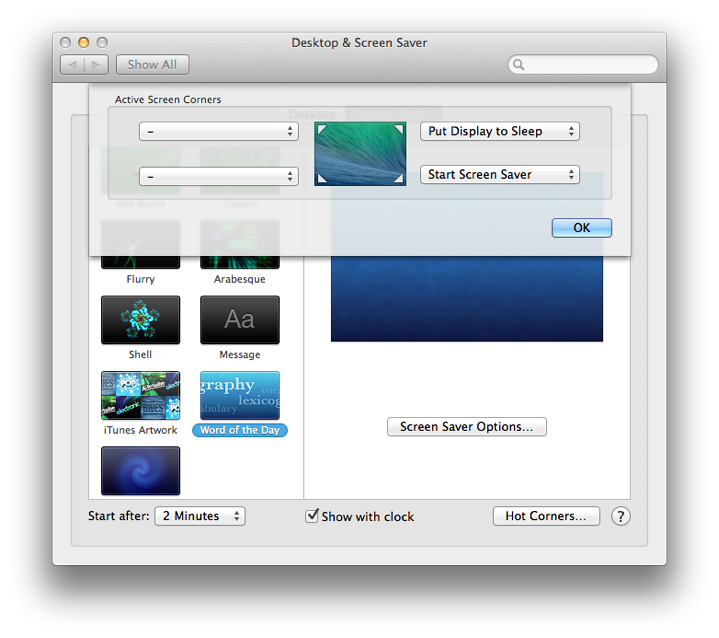System Preferences in OS X 10.9, Mavericks: Desktop & Screensaver

AMITIAE - Sunday 27 October 2013
|
System Preferences in OS X 10.9, Mavericks: Desktop & Screensaver |
 |
|
|
By Graham K. Rogers
DesktopA change in the way the desktop images display has been introduced. Previously, selecting a desktop picture would display that image on every desktop or space as Apple now calls them (see Mission Control). Now each space can have a separate desktop picture.


Also see the note below the Screensaver images section. iPhoto albums are also included, giving access to a user's own photographs. As I use Aperture I added these albums. Below these two menu items are Pictures folders. Using a + icon at the bottom of the panel a Finder panel opens and we may also add our own folder selections. The - icon removes unwanted folders. When any folder is highlighted, the available images in that folder appear in the main panel. Clicking on any picture makes that the desktop picture for the current space. The picture also appears as a thumbnail but will change as a new space is accessed. There is no Undo button.

Below the panels are three checkboxes. Selecting the first makes it possible to change the picture with several time-settings, from 5 seconds up to a day. There are two other options in that menu: "When logging in" and "When waking from sleep". This feature only works for those spaces it is applied to: a user can have one or more spaces that change the pictures, while others keep the same image. At the bottom of the panel is a checkbox that toggles the translucent menu bar (at the top of the screen) On or Off. When checked, the menu bar is semi-transparent; when unchecked it is solid white. If an image from any user's folders is selected, there are five ways to display the image (Fill Screen, Fit to Screen, Stretch to Fit Screen, Center, and Tile): accessed by a button to the right of the thumbnail. Images from the Apple folders do not have these options.
Screen SaverThe Screen Saver panel is closely similar to how this appeared in OS X 10.8, Mountain Lion although not grouped as Slideshows and Screen Savers. These are now a single group of 21 options. The top 14 options are the same as the slideshows available before: Floating, Flip-up, Reflections, Origami, Shifting Tiles, Sliding Panels, Photo Mobile, Holiday Mobile, Photo Wall, Snapshots, Vintage Prints, Scrapbook, Ken Burns and Classic. Thumbnails of the slideshows are shown in the left hand panel. All 14 use the Ladybug desktop picture as illustration.

Users may also choose from the Library or any suitable folder. As a source is selected, so a slideshow of sample images is displayed in a small window above the selector button. A checkbox below the selector button is to allow shuffling of image order.
When one of the screen savers is selected a mini version appears in the window to the right and a button for available Options can be pressed. These are not the same for each screen saver and not all screen savers have options:
There are three additional controls at the bottom of the screen: a button for selection of the time to start the screen saver (Never and time intervals from 1 minute to 1 hour); a checkbox for "Show with clock"; and a button for Hot Corners. This opens a panel which has four buttons for actions when the cursor is moved to the four corners of the screen. In my case, I use top right to Put Display to Sleep; and bottom right to Start Screen Saver. Other actions available are Disable Screen Saver, Mission Control, Application Windows, Desktop, Dashboard, Notification Center, Launchpad and a dash (-) for no action.

NoteIn an article put out a couple of days after the release of OS X 10.9, Mavericks, Thorin Klosowski, writing on LifeHacker, pointed out that images provided for screen-savers (such as the National Geographic images) could also be used as desktop wallpapers.As above, this may be done by using the + icon at the bottom of the Desktop panel. In the Finder panel that opens we may use the Finder menu to access the /Library/Screen Savers/Default Collections/ and add any folders required. [Klosowski writes that the images could be copied using the Finder, but they are accessible this way as well.]
See Also:
Graham K. Rogers teaches at the Faculty of Engineering, Mahidol University in Thailand where he is also Assistant Dean. He wrote in the Bangkok Post, Database supplement on IT subjects. For the last seven years of Database he wrote a column on Apple and Macs. |
|

For further information, e-mail to

|